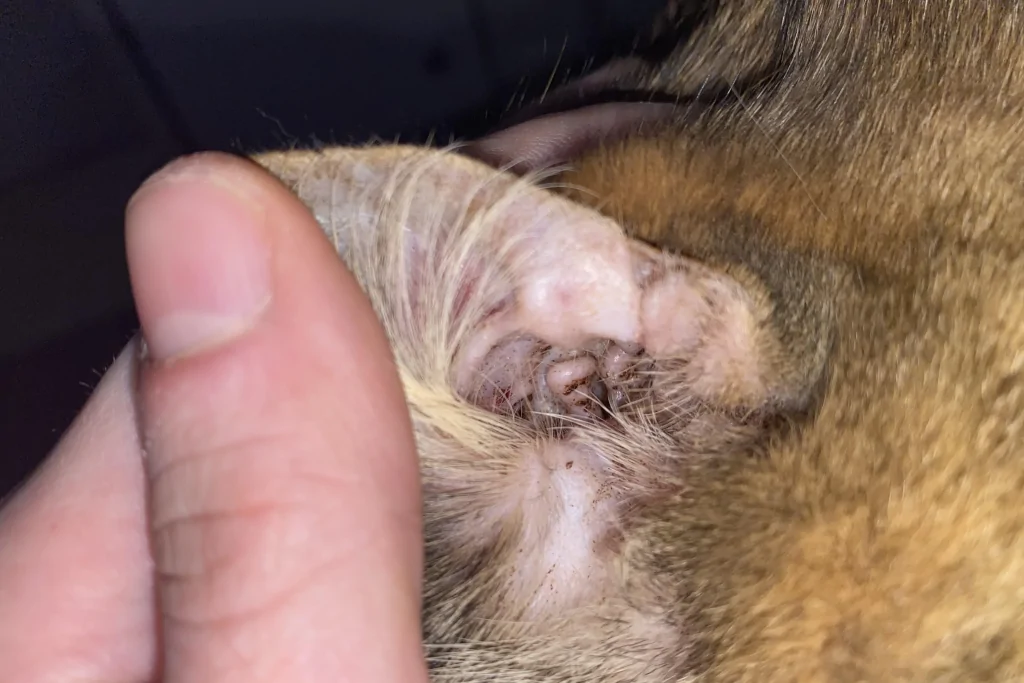Disclosure: We may earn a commission from helpful, relevant links in our content. No cost to you. See our privacy policy.
Imagine the joys of pet parenthood, the sloppy kisses, the tail wags at your return – yet, an overlooked tickle in your pup’s ear can swiftly take away this cheerful symphony.
If your dog has been pawing at their ears or shaking their head more often than usual, you might be dealing with a tiny but prevalent problem – ear mites.
We get it, nobody wants to see their furry friend in distress. While ear mites can sound intimidating, rest assured, they’re manageable with the right knowledge at your disposal.

What Are Ear Mites? A Tiny But Troublesome Pest
We’ll begin our journey by getting to know these tiny hitchhikers.
Ear mites, scientifically known as Otodectes cynotis, are microscopic parasites that make their home in the ears of our canine companions. Although they’re tiny, these pests can cause a fair amount of trouble, inducing intense itching and discomfort in dogs.
They survive by feeding off the ear wax and oils within your dog’s ears, often causing inflammation.
A single ear mite life cycle lasts about three weeks, but the trouble doesn’t stop there. The fast reproduction rate of these parasites could turn a minor issue into a significant concern if left unchecked.
How Can You Recognize the Signs of Ear Mites in Your Dog?
While the pesky critters themselves are hard to spot without a microscope, the symptoms they cause are quite apparent.
If your dog has ear mites, they’ll likely scratch their ears excessively or shake their heads frequently. You might also notice a strong odor and a dark, coffee-ground like discharge from their ears.

These signs are not exclusive to ear mites as other ear issues can cause similar symptoms. However, they should be a trigger to schedule a visit to the vet for a proper diagnosis.
Remember, early detection is the first step towards a happy, itch-free life for your pup.
Potential Complications from Untreated Ear Mite Infections
Even the most attentive pet parents can face an ear mite outbreak, and trust me, I know how it feels.
I still remember how Sam, my older dog, kept shaking his head one late night. He was usually a deep sleeper, so his restlessness was concerning. The next morning, I noticed a dark discharge from his ear – our first encounter with ear mites. It was an ordeal for both Sam and me, primarily because I underestimated the problem, thinking it would resolve on its own. But boy, was I wrong.
If ear mite infestations are left untreated, they can lead to some serious complications. These complications include severe skin or ear infections as the constant scratching can break the skin barrier, allowing harmful bacteria to enter.
In Sam’s case, his neglected ear mite problem turned into a painful ear infection that required a lengthy treatment.
Furthermore, incessant head shaking and scratching can lead to a condition known as an ‘aural hematoma,’ where blood vessels in the ear flap burst, causing painful swelling.
Believe me when I say, you don’t want your furry friend to go through this – it’s not a pleasant sight. It was a wake-up call for me to pay more attention to these seemingly ‘minor’ issues that could escalate quickly.
Suggested reading: Dog Care – Your Dog’s Ear Cleaning Guide
Treatment Options for Ear Mites (OTC vs. Vet Prescribed)
There are generally two paths to choose from when treating your dog’s ear mites: over-the-counter (OTC) products and vet-prescribed treatments. The best option depends on various on the severity of the infestation and your dog’s overall health condition.
Over-The-Counter Treatment
The market is flooded with over-the-counter (OTC) ear mite treatments for dogs.
These usually come in the form of ear drops or creams that need to be applied directly into your dog’s ear canal. OTC treatments typically contain pyrethrins or pyrethroids, chemicals that are toxic to mites but safe for dogs and can effectively eliminate ear mites when used correctly.
Some of the ones I’ve personally found effective include Miracle Care R-7M and Hartz UltraGuard. They are available as ear drops or creams and need to be applied directly into your dog’s ear canal.
However, remember to follow the instructions on the product label closely, as the duration of treatment may vary.
Vet Prescribed Treatment
While OTC treatments can be beneficial, in severe or persistent cases, a visit to the vet is indispensable. The vet may prescribe stronger medications like selamectin or ivermectin, which are typically applied topically or given orally.
I have seen good results with Revolution, which contains selamectin. Next to ear mites, it also eliminates stomach parasites. Chewy is fast to deliver, and the product is easy to apply.
In some instances, the vet may also recommend a thorough ear cleaning under anesthesia, particularly if there’s a lot of debris or if a secondary infection has set in, like in Sam’s case.
They may also provide medications to address secondary infections or inflammation, which are typically more potent and faster-acting than OTC options.
Remember, each dog is unique, and what works for one may not necessarily work for another. It’s always advisable to consult with your vet before starting any treatment regimen. They’ll guide you based on your dog’s health history and the severity of the infestation.
And as I learned from Sam’s experience, timely intervention can save a lot of discomfort for your four-legged friend.

How Can You Prevent Ear Mite Infestations on Your Dog?
To keep your dog’s tail wagging and ears mite-free, prevention is undoubtedly the best course. As a seasoned dog parent, I can tell you that prevention doesn’t have to be an arduous task. A few simple measures can go a long way in keeping these microscopic nuisances at bay:
- Regular Ear Checks. Keep an eye out for signs of an infestation, such as a dark, coffee-ground like discharge or excessive scratching. Early detection means quicker relief.
- Clean Your Dog’s Ears. Use a vet-recommended cleaner and follow their instructions carefully. Regular cleaning not only helps prevent mite infestations but also keeps other ear infections away. But don’t clean too frequently as it can disrupt the natural balance of the ear.
- Maintain A Clean Environment. Ear mites can live in your dog’s bedding and surroundings, waiting for the next host. Regularly wash their bedding and clean areas where your dog spends the most time.
- Check All Pets in The Household. If you have multiple pets, ensure they are all checked and treated for ear mites. Ear mites can easily spread between pets.
Suggested reading: Doggy Care 101 – How to Clean Your Dog’s Ears
FAQs
Can ear mites spread from dogs to cats, or vice versa?
Yes, ear mites can indeed spread from dogs to cats and vice versa. These parasites are not picky about their hosts and can quickly jump between different animals in close contact.
How long does it take for ear mites to go away after treatment?
The timeline for ear mites to go away after treatment can vary. Typically, with appropriate treatment, ear mites should be eradicated within four weeks. However, this can depend on the severity of the infestation and the treatment used.
Can ear mites cause permanent damage to my dog’s ears?
While ear mites themselves may not cause permanent damage, the secondary issues they provoke can. Persistent scratching can lead to severe infections or conditions like aural hematomas that, if untreated, can cause lasting harm.
Are some dog breeds more prone to ear mite infestations?
Certain dog breeds with floppy ears, like Cocker Spaniels or Basset Hounds, may be more prone to ear mite infestations due to the warm, dark environment their ears provide. However, any dog, regardless of breed, can get ear mites if exposed.
Alex, a passionate animal lover, has experience in training and understanding animal behavior. As a proud pet parent to two dogs and three cats, he founded AnimalReport.net to share insights from animal experts and expand his knowledge of the animal kingdom.




